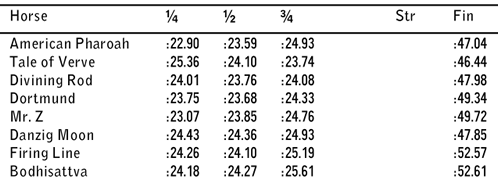American Pharoah

Credit: Churchill Downs/Reed Palmer Photography
American Pharoah breezed four furlongs in :48 flat at Churchill Downs on Tuesday morning, galloping out five furlongs in 1:00.40 and six furlongs in 1:13.20. Martin Garcia, who flew into Louisville along with trainer Bob Baffert for the work, could be heard shouting “Whoa” as he tried to pull up the Pioneerof the Nile colt on the backstretch. “I told Martin to just let him keep going,” said Baffert. “I really liked the way he went.” Here’s video of the work.
The trainer is happy with the dual-classic winner’s apparent energy level:
Baffert has brought three colts to this stage before, and he has said this is the point where one would usually start noticing any fatigue from the five-week Triple Crown grind.
Both Baffert’s body language and that of his Kentucky Derby and Preakness-winning charge Tuesday signaled that was not the case as American Pharoah cruised along under Garcia. The colt’s ears pricked the entire way around.
DRF clocker Mike Welsch gave the work a positive review (subscription only):
Even on the live feed provided by the track, it was clear to see American Pharoah looked every bit as good on Tuesday breezing over the Churchill Downs surface as he did in the final week leading up to his victory in the Kentucky Derby. With jockey Martin Garcia aboard, American Pharoah appeared a picture of health and was about as relaxed as could be as he made his way around to the half-mile pole alongside the pony …
American Pharoah just cruised through a steady series of 12-second eighth-mile splits before galloping out with a ton of energy around the turn. The gallop-out was perhaps the most impressive part …
American Pharoah is expected to work again on Sunday or Monday*, and then ship to New York on Tuesday for the Belmont Stakes. “We won’t do much with him up there,” said Baffert. “We’re just going to stay focused, keep the weight on him and keep him happy like the way he looks today.”
Dealing with the media at Belmont will be the trainer’s challenge next week: “I can’t go into Marshawn Lynch mode, but it’d be nice.”
It’s likely, if he wins the Triple Crown, that we’ll have seen the last of American Pharoah on track. His stud plans are set. Ed DeRosa breaks down the deal:
The deal started out at $8-million with another $7-million available if American Pharoah hit certain benchmarks like become champion two-year-old male and win certain races such as the Kentucky Derby. Presumably there are other incentives still in play such as win the Triple Crown, become champion three-year-old male, and earn Horse of the Year.
And don’t get too excited if he’s on the cover of Sports Illustrated.
Experts estimate Pharoah would be at the high end of the market with a Triple Crown win: “[H]e’s likely to command approximately $100,000 per live foal.”
*2:30 PM Addendum: I had to look this up — it turns out, American Pharoah will be the first Triple Crown contender to go into the Belmont Stakes gate with two works between the Preakness and the Belmont since Funny Cide in 2003. Both California Chrome in 2014 and Big Brown in 2008 had one work.
Victor Espinoza sums up California Chrome’s 2014 Belmont Stakes effort:
“California Chrome was tired going into the race and his energy wasn’t quite what it was. Also, another horse stepped on his foot and that happens when a horse doesn’t have the energy it should. They do things in slow motion, and that’s what happened.”
The week before, California Chrome was “ready,” had “a perfect work,” was full of “tremendous energy,” and “seemed to have plenty left in the tank.” Pointing those quotes out is a reminder, mostly to myself, not to get too caught up in whatever hype there is about American Pharoah as he preps for the Belmont over the next two weeks. He “looks great,” but he also had to “recuperate” from winning the Preakness by walking for four days at Churchill, and his time exercising each morning is so far being reported in single-digit minutes.
Meanwhile, challengers such as Materiality, who skipped the Preakness, are training like the fresh horses they are. The son of 2005 Belmont Stakes winner Afleet Alex “solidified his status … as the major threat to American Pharoah,” working five furlongs in :59.87 at Belmont Park on Friday (video).

Sealed, opened, soaked: The condition of the Pimlico track surface became the X factor in the Preakness Stakes when a torrential downpour turned the dirt to mud minutes before post time on Saturday. If anything, the rain was a boon to the 4-5 favorite, already a winner on a wet track. But nothing can be taken for granted in a Triple Crown race: “I took a chance and sent him as quick as I can,” said rider Victor Espinoza, explaining how he hustled American Pharoah from stall #1 and into the lead from the start, outmaneuvering jockey Martin Garcia and stablemate Dortmund, in stall #2, at the break.
American Pharoah won the 1 3/16-mile race by seven lengths in a final time of 1:58.46, “the slowest for the Preakness since 1956, when Fabius was the winner over Needles and No Regrets on a fast track in 1:58 2/5.” Here are the individual fractions from the Daily Racing Form chart:

The winner’s split for the mile was :26.32, and for the final 3/16ths, :20.72 (both those numbers from the official Equibase PDF chart). So, American Pharoah slowed down at the end after a quick opening quarter, and I’m inclined not to read too much into what’s 1) a typical race shape for dirt routes, 2) a pretty good example of what we mean when we talk about tactical speed (see, not only the break, but the way American Pharoah draws away from the others rounding into the stretch), and 3) a finish without challenge (Dortmund checked out, Mr. Z tired out, and Firing Line never fired) over slop.
Jay Privman reports that American Pharoah earned a Beyer speed figure of 102. TimeformUS’ figuremaker gave him 125. He was awarded figures of 105 and 127, respectively, for winning the Kentucky Derby.
“I’ve never won this race as easily and handily,” said trainer Bob Baffert after. The ease does seem almost supernatural, or maybe that’s just the rain:
https://www.youtube.com/watch?v=SxXQASkvBjI
American Pharoah’s Preakness win was the sixth for Baffert; his Belmont Stakes start will be the trainer’s fourth shot at a Triple Crown, the third for Espinoza.
“It’s hard for me to imagine I’m going through this again,” the trainer told the NYRA press office on Sunday morning, and quipped that he’d like a fast track at Belmont. “Like the one Secretariat had. I’ll take that.”
The Belmont Stakes is June 6, and there are currently eight likely contenders, in addition to American Pharoah, including Preakness runner-up Tale of Verve, Peter Pan winner Madefromlucky, and Kentucky Derby runners Frosted, Materiality, Keen Ice, Carpe Diem, Frammento, and Mubtaahij.
British bookies are taking bets — Ladbrokes has Pharoah at even money.
1:15 PM Addendum: American Pharoah was the only horse to gallop back without a mud mask, thanks to his gate-to-wire run, but he was carrying a little extra water weight via Espinoza’s boots.
Copyright © 2000-2023 by Jessica Chapel. All rights reserved.